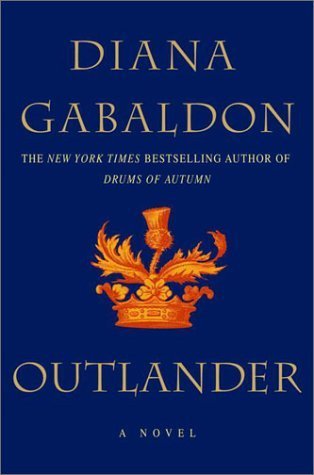Diana, Philippa, or Nora? Take Your Pick
It was my brother, John—a manly man, who thinks The Gulag Archipelago is light summer reading—who turned me on to Diana Gabaldon. Somewhere in our fifties, John and I discovered that our preferences in music and literature intersected more than we might have thought. His taste runs toward Ray Charles, mine toward Ry Cooder. But we both like bluegrass, mysteries, and historical fiction.
It’s my hunch that Diana Gabaldon caught the reading public’s fancy with the steamy sex in her first novel, Outlander, and then, in succeeding books, pumped up the history and toned down the sex. A little. Claire and Jamie are getting on in years, after all, though Claire’s still vain about her “unruly curls,” even if she pretends not to be, and Jamie’s still built like a redwood, and of course we still have Roger and Brianna’s heat to fan ourselves against, and….
I’m sorry. Are you lost?
Diana
A little over ten years ago, John sent me Diana Gabaldon’s first four novels, insisting that I read them in the proper order. I didn’t read novels then. I was writing for the business world, and all my reading dealt with marketplace trends. For recreation, I dipped into books about English-language history, grammar, style, and usage. Outlander remained unread, though John kept nagging. It’s our Scots heritage, he said, that had pulled him in, and his fascination with the idea of time travel.
I always took two weeks off at Christmastime, and everything went to all to hell the Christmas of, I think, ’99, and I desperately needed a diversion, so I picked up Outlander and barely drew a breath until I finished Drums of Autumn, the fourth book in the series, about ten days later. I packed the four paperbacks off to my daughter, and she opened Outlander and then forgot to feed and clothe her children for a couple of months.
I pined for the fifth book, and then the sixth. Most of the English-speaking world is impatient for the promised seventh.
It got so that I could sniff out Gabaldon aficionados, people I casually did business with, knew only by phone or e-mail. I marveled that Diana Gabaldon, who, I believe, has a Ph.D. in marine biology, could write with such fluid, picturesque, assured precision about the eighteenth-century Scottish highlands. I thought that she had spoiled me for other authors… that I would never be able to read anyone else’s novels… that I’d have to go back to reading about corporate culture and profit-sharing.
Philippa
About four years ago, my daughter, Marian, presented me with a wicked new indulgence—the historical fiction of Philippa Gregory. The book was The Other Boleyn Girl. I devoured it. Philippa Gregory doesn’t do steamy sex in her books, really (with the exception noted a few paragraphs down), although the most erotic passage I’ve ever read in any book is Gregory’s depiction of Mary Boleyn and the commoner William Stafford snuggling, fully clothed, on a deserted beach in France.
Gregory has written five novels about the Tudors. I started reading The Queen’s Fool late one Monday night and called in sick on Tuesday. (A sixth book, The Other Queen, about Mary, Queen of Scots’, imprisonment in England, is due out this fall.)
Whereas Gregory writes about people who actually existed, Gabaldon’s main characters are invented, so the question of historical accuracy is less urgent in Gabaldon’s work. It doesn’t trouble me, particularly, in Gregory’s books. I can read the facts in the encyclopedia, but I can’t become immersed in the inconveniences, the injustices, the excesses, and the intrigues of sixteenth-century British royalty—a microcosm that Gregory presents with such exquisite timing and drama. There is, literally, never a dull moment in Gregory’s prose.
(I tried to read Gregory’s first novel, Wideacre, published in 1987. The “heroine’s” amorality was so repellent, complete with steamy sex involving her own brother, that I couldn’t finish the book. Kathleen Winsor’s Forever Amber [1944] presents a much more sympathetic but equally selfish heroine, and Winsor is more astute about the plight of independent-minded women in the seventeenth and eighteenth centuries.)
Nora
Dare I link Nora Roberts’s name with Gabaldon’s and Gregory’s? Nora Roberts, who has had 124 novels on the New York Times bestseller list? Whose books in print exceed 280 million copies? Who produces a new book more often than I dust?
After my most recent Roberts-fest, the “MacGregors” series, I asked myself, once again, “How does she do it?” How, that is, does she write the same story, over and over and over again, putting her characters into different bodies and different scenic locales (usually by the turbulent sea, Atlantic or Pacific), giving them different names and occupations, but telling essentially the same tale?
She does it beautifully, though I confess I cringe every time she uses disinterested when she means uninterested. Still, I am seldom distracted by careless writing mistakes or poor editing. Her research must be fascinating, and exacting. The men and women who populate her books are very believable cops, boat-builders, U.S. senators, cartoonists, witches, racecar-drivers, innkeepers, sculptors, carpenters, fashion models, certified public accountants, four-star chefs, and horse breeders. None of them, it must be said, is fat or ugly, and if a character in one of her books is short of cash, it’s only temporary.
Boy meets girl, boy is rudely antisocial, girl is fiercely independent, the barriers come down, the clothes come off, someone puts a fly in the ointment, it gets fished out, I’m mixing metaphors, pay no mind, and boy and girl get married, have at least three children, and live happily ever after. If we’re fortunate, as in the case of the MacGregors, we get to read about several generations of lusty young men and women repeating the errors of their elders, toughing it out, proving they can make it on their own, discovering they don’t have to, and, finally, making new grandbabies for The MacGregor—Daniel, the patriarch, who built the castle by the sea—though he claims it’s his beloved Anna, the surgeon, who fusses.
The principals are virtually always caucasian (often of Irish or Scottish descent, though there are French and Comanche strains running through the extended MacGregor clan) and robustly heterosexual, but their close friends might or might not be black, or gay, or both. Roberts writes very comfortably, never coyly, about interracial and gay couples, neither making an issue of “diversity” nor backing away from it.
Her gift, I think, is the ability to pick you up and plop you down in some irresistible setting—an island along the New England or Georgia coastline, a clifftop near Monterey, occasionally a sunset town in Montana—and then surround you with charming people—utterly innocent, thoroughly jaded, and everything in between… and you get to live there for a while, in the beautiful, kaleidoscopic whirlwind she’s painted, and watch people grope their way toward each other… and it’s just lots of fun. Every damn time.
And I learn from them all—these made-up people with genuine humanity—the creations of Gregory, Gabaldon, and Roberts. They inspire me, even if it’s only to have a tidy, well-organized workspace like Cybil Campbell in Roberts’s The Perfect Neighbor. They never let me forget—as engrossing and colorful as their lives and times are, there, on the pages, their affairs so tidy one minute, so messy the next—to live my own life first and peek in on theirs only after my chores are done. Well, except for that “sick day” I spent reading The Queen’s Fool… but I’ve learned my lesson, and it will never happen again… at least not until September….
——-
California Central Coast photo by Paul Lee
A marvelously engrossing read is Audrey Niffenegger’s The Time Traveler’s Wife. Couldn’t be less like Gabaldon’s approach to time travel. Marian gave me The Time Traveler’s Wife for Christmas a few years ago and asked to borrow it after I was done. When I relinquished it, I begged her to finish it quick because I wanted to reread it. A day or two later she called me. “Are you sure you want it back?” she wanted to know. “How can you DO that to yourself again?”




I see toy talk about time travel. If you like the subject, come see my Timeship as well. Godspeed!
Hey, you have a great blog here! I’m definitely going to bookmark you! Thank you for your Thank you For Best Content
Books Nora Roberts